Our compilation comparing average conversion rates for retail sites and other industry sectors
As you will know, conversion rate is often used as a KPI to review the effectiveness of Ecommerce sites. Naturally all site managers and owners want to know, "how do our conversion rates compare?"
In this post I have compiled different free industry sources focusing on retail Ecommerce conversion, but towards the end of the post, a chart shows average conversion rates for a range of sectors including B2B conversion. At the end of this article we also feature an analysis of Unbounce landing page lead generation conversion by sector.
Before we get to the stats, one other caveat on analysis of conversion rates:
When benchmarking conversion rate, we think it's important to explain to marketing managers that they should go beyond headline conversion rates to segment conversion by different types of visitor.
To see why, see Dan Barker's excellent post explaining why conversion rate is a horrible measure to focus on...
December 2017 update - retail conversion rates by device
The Monetate Ecommerce Quarterly is a great source giving regularly updated benchmarks on conversion segmented by devices and media for large Ecommerce brands.
Their latest quarterly update shows conversion rates to add-to-basket or cart and below conversion to sale across the last 5 quarters:
| Conversion Rates | Q1 2016 | Q2 2016 | Q3 2016 | Q4 2016 | Q1 2017 |
|---|---|---|---|---|---|
| Global | 3.1% | 2.81% | 2.52% | 2.94% | 2.48% |
| US | 3.04% | 2.76% | 2.48% | 2.97% | 2.46% |
| UK | 4.5% | 4.09% | 3.88% | 3.94% | 3.57% |
| Conversion Rates by Device | Q1 2016 | Q2 2016 | Q3 2016 | Q4 2016 | Q1 2017 | |
|---|---|---|---|---|---|---|
| Global | Desktop | 4.23% | 3.88% | 3.66% | 4.25% | 3.63% |
| Smartphone | 1.42% | 1.31% | 1.17% | 1.49% | 1.25% | |
| Tablet | 3.59% | 3.44% | 3.21% | 3.79% | 3.14% | |
| US | Desktop | 4.28% | 3.94% | 3.75% | 4.41% | 3.73% |
| Smartphone | 1.27% | 1.16% | 1.03% | 1.40% | 1.14% | |
| Tablet | 3.46% | 3.33% | 3.08% | 3.80% | 3.06 | |
| UK | Desktop | 6.34% | 5.88% | 5.57% | 5.78% | 5.15% |
| Smartphone | 2.83% | 2.62% | 2.59% | 2.66% | 2.52% | |
| Tablet | 4.58% | 4.34% | 4.22% | 4.38% | 3.85% |
With shoppers increasingly using smartphone and tablet to purchase, it's vital for online retailers to know conversion benchmarks they should be achieving on smartphone device. You can see that typically mcommerce conversion rates are around half of those on desktop. Improvements in mobile experiences over the past years haven't impacted this figure, showing that smartphone is more popular as a device for browsing products while desktop is preferred more for transacting
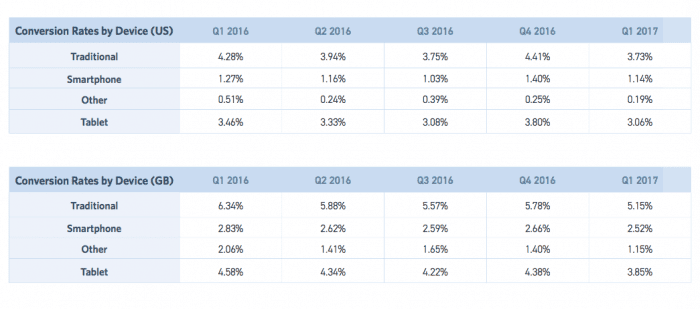
December 2017 - Mobile conversion rates by traffic source or referrer
It's rare to see conversion comparisons by traffic source. This data is from an analysis of over $1 billion in sales on the Shopify platform over Black Friday / Cyber Monday when 64% of sales were on smartphone, a 10% increase from the previous year.
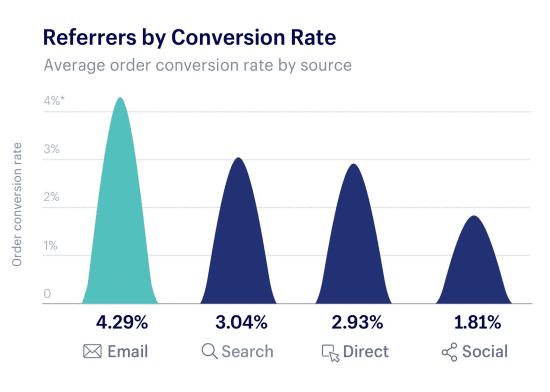
You can see that email is the highest converting channel. We would expect this since email subscriber lists contain customers (and some prospects) that have higher conversion. Bear in mind that conversion rates for sales events can be significantly higher than during normal trading. Search visits are significantly higher converting than social since search has higher intent if someone is looking for a specific product or brand. Social media conversion has lower intent. Also since > 80% of social media browsing is on smartphone this will also decrease conversion since we have seen smartphone convesion is lower than desktop.
Mobile retail conversion rates
This report from the Adobe Digital Index retail report has a simple table comparing cart and visit (overall) conversion on smartphone vs tablet vs desktop. It shows that visit conversion is nearly 3 times higher on desktop vs smartphone.
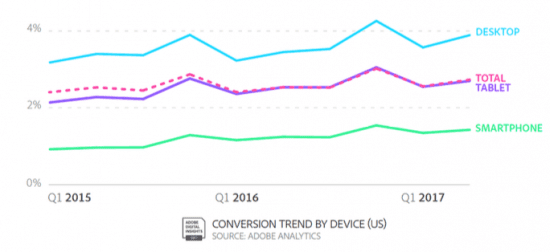 Here are the tablulated figures:
Here are the tablulated figures:
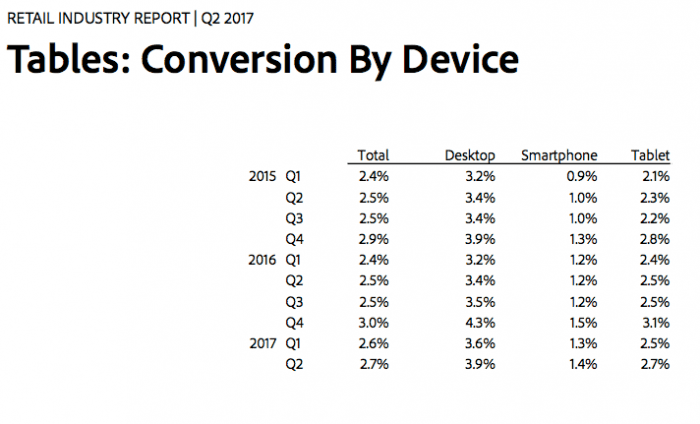
- Location: US Retail
- Date: Published Autumn 2017 (2016 data)
- Sample: Top 250 US retailers (so representative of common consumer behaviour)
- Source: Adobe Retail Industry report
If you're creating a business case for mobile optimised sites as explained in our Ecommerce mobile and desktop wireframes guide or mobile marketing strategy guide, this data is also valuable since it shows the variation in conversion rate by mobile devices type. Tablet conversion rates are similar, but slightly lower than desktop conversion rates, suggesting people are increasingly comfortable with the experience of buying on tablets.
However, it's a different story for Smartphones since these convert at one-third to one-quarter of the rate of traditional or tablet devices.
This suggests smartphones are more of browse or research platform rather than a buy platform since many of the large retailers featured in this survey will have mobile optimised sites. Smartphone experiences should be personalised to show this different form of usage. The lower conversion rates for mobile devices are also shown in these compilations of Android vs MacOS vs iOS operating systems, which gives the latest 4th quarter data released in early 2017.
Conversion rates by channel
Conversion rates for other sectors: telecoms and travel
These are available in the Adobe Digital Index (ADI) - this data is available in the April 2016 published data for the whole of 2015.
Conversion rates for US vs Europe vs Asia Pacific for the travel industry
The ADI report also compares conversion for EMEA countries against the US. UK and US conversion are significantly lower than other European countries perhaps because of less competition or Amazon being lower in these countries. Different rates of smartphone adoption will also affect this cross-platform average.
Options for segmenting conversion rate
As Dan Barker suggests in his advice we mentioned at the start of this post, conversion rate gets more useful as you break it down by different types of visitors with different intent and a different relationship with the retailer. Different conversion rates and average order values can then be segmented for different audiences to understand and work to improve the quality of traffic or strength of propositions, for example:
- First time, repeat visitor or registered customer conversion
- Referring channel conversion, e.g. paid or natural search, social media, affiliates, display advertising
- Search type, e.g. paid or natural, brand, generic or long-tail
- Product category type - conversion rates are much higher for simple commodity products for example - flower purchase (double-digit percentage) compared with a higher cost product that will often be purchased in store (for example beds or furniture which will often be less than one percent).
- Promotion type or seasonal sale - the IMRG data and Coremetrics data below shows that conversion rate can increase dramatically at these times.
Conversion rates for non Ecommerce sites including B2B conversion
I'm also often asked about conversion rates in other sectors, particularly for business-to-business lead generation. While similar caveats about sub-category, type of visitor and strength of brand apply, this is a useful compilation from this older Marketing Sherpa of average conversion rates by industry sector.
Lead generation and landing page conversion rates by sector
However, this gives 'self-reported' conversion rates for lead generation, so it was good to see this new Landing page lead generation conversion rate research from Unbounce giving lead conversion rates by industry particularly since it's based on real-data of conversion rather than reported data which is more common for B2B and other sectors. Industries covered include business-to-business, Travel, Healthcare, Legal and Education sectors.
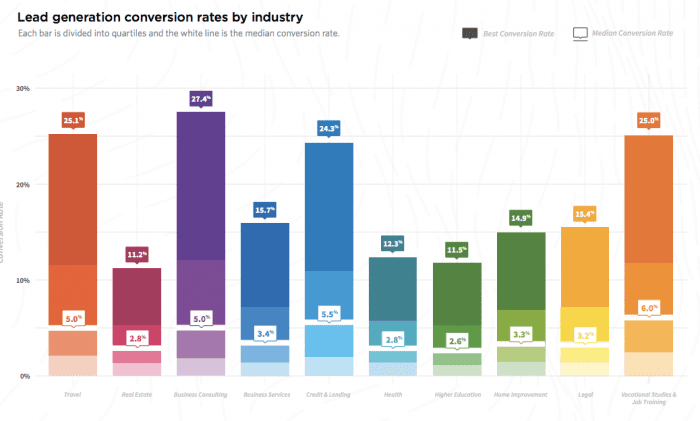
source https://www.smartinsights.com/ecommerce/ecommerce-analytics/ecommerce-conversion-rates/

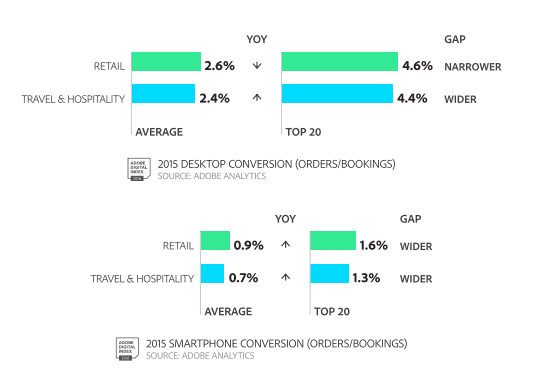
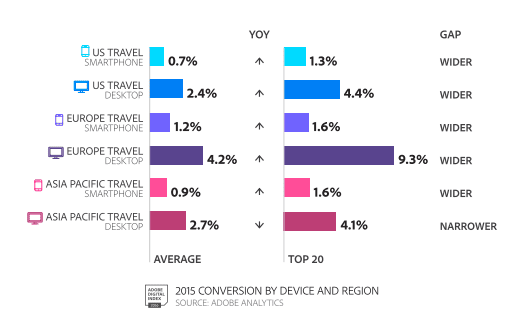
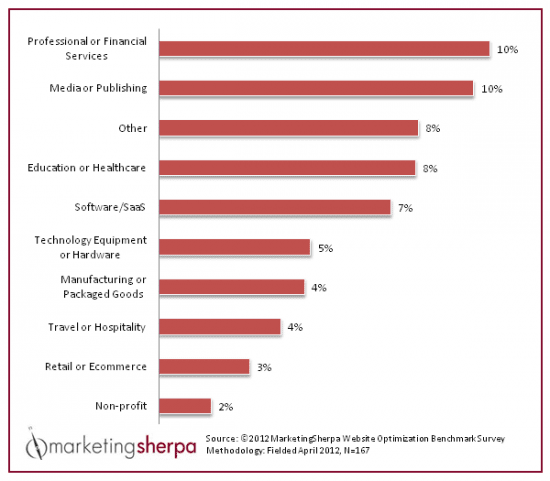
No comments:
Post a Comment